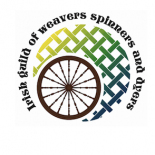
Ethel Mary Partridge, Ethel Mary Mairet RDI, or Ethel Mary Coomaraswamy was a British hand loom weaver, significant in the development of the craft during the first half of the twentieth century.

Spinning is an ancient textile art in which plant, animal or synthetic fibres are drawn out and twisted together to form yarn. For thousands of years, fibre was spun by hand using simple tools, the spindle and distaff. It was only with the invention of the spinning wheel in the Islamic world circa 1030, and its subsequent introduction to China, India and Europe in the High Middle Ages, that the output of individual spinners dramatically increased. Mass production later arose in the 18th century with the beginnings of the Industrial Revolution. Hand-spinning remains a popular handicraft.

Craft Ontario, legally known as the Ontario Crafts Council (OCC), is a member-based, not-for-profit arts service organization based in Toronto, Ontario, Canada. The organization is dedicated to promoting the recognition and appreciation of craft and craftspeople in Ontario and beyond.
Mary Ellouise Black, an occupational therapist, teacher, master weaver and writer, created almost single-handedly a renaissance in crafts in Nova Scotia in the 1940s and 1950s. Her best-known book, ‘’The Key to Weaving", was published in 1945 and has since run to 3 editions and numerous printings. Its clarity is without parallel, and, more than half a century later, it remains a handweaver's prime source of information.
Jarko Zavi (1907–1987) was a Czech-born Canadian ceramist and sculptor who lived and worked principally in Ontario. After attending art college in Czechoslovakia, he worked producing fine china at the Terra Company for twelve years, rising to head of ceramics design. Zavi fled to Canada just five days before the outbreak of World War II. Soon after emigrating, he married Nunzia D'Angelo (1900–1968), a maker of majolica and folk pottery, and they had two daughters together. First located on Gerrard Street in Toronto, the couple renamed their kitchen factory the Ceramic Art Studio. During the war years they produced a large array of ornamental pieces, sought after by buyers. Their output included ceramic fish, prancing horses, vases, candle holders, bowls, teapots and earrings. Zavi diligently experimented with glazes, and he was able to produce colours that included Chinese red. In 1945, he sculpted a bust of Tomáš Masaryk, the first president of Czechoslovakia, which was unveiled at a public ceremony with the mayor of Toronto present.
Ezra Schabas, was a Canadian musician, educator and author. He was active in Canada's musical life beginning in 1952, when he emigrated from Cleveland with his family. During his time in Canada, he was a leading musical educator, clarinetist, and administrator in Toronto's musical institutions. He wrote several books on Canadian and American musical history, and he was appointed to the Order of Ontario and made a Member of the Order of Canada.

Bobs Cogill Haworth (1900–1988) was a South African-born Canadian painter and potter. She practiced mainly in Toronto, living and working with her husband, painter and teacher Peter Haworth. She was a member of the Canadian Group of Painters with Yvonne McKague Housser, Isabel McLaughlin and members of the Group of Seven.

Esther Marjorie Hill was a Canadian architect and the first woman to graduate in architecture from the University of Toronto (1920).
Polly Barton is an American textile artist.

Mabel Cawthra Adamson (1871–1943) was a Canadian painter and decorator, who was active in the Arts and Crafts movement in Toronto.

Berta Frey was a well-known New York weaver, who spoke and taught about weaving techniques for many years. She was one of the founders of the Handweavers Guild of America.
The Fletcher Farm School is an arts and crafts school in Ludlow, Vermont, USA, operated by the non-profit Society of Vermont Artists and Craftsmen. Courses are given on weekends in winter and spring, and during the summer. The school teaches a broad range of skills including fiber arts, woodworking, pottery, jewelry and photography.
The Canadian Guild of Potters was a non-profit organization of Canadian ceramic artists that was active from 1936 to 1978.

The Handweavers Guild of America (HGA) is an association of fiber artists founded in the U.S. in 1969. The guild provides educational programs, conferences, and scholarships for fiber arts students. It publishes the quarterly journal Shuttle Spindle & Dyepot.
Yvonne Sloan is a New Zealand weaver and textile artist.
Mary Meigs Atwater was an American weaver. She revived handweaving in America by collecting weaving drafts, teaching and writing; Handweaver and Craftsman called Atwater "the grand dame and grand mother of the revival of handweaving in [the United States]".

Dorothy Kate Burnham LL. D. was a Canadian textile scholar, author and museum curator.
Eugene Weavers' Guild is a non-profit organization of weavers, spinners, and other fiber artists in Eugene, Oregon, in the U.S. It was founded in 1946 and has been meeting monthly for more than seventy years. As of 2016, the Guild included 85 members, ranging in skill from hobbyist to professional weavers, from Eugene, Springfield, and rural communities of surrounding Lane County, Oregon, USA. The Guild sponsors workshops, a lending library, skill demonstrations in a variety fiber arts, equipment sharing, and events to raise funds for local charities.
Karen Bulow was a Danish-born Canadian textile artist.

The Irish Guild of Weavers, Spinners, and Dyers (IGWSD) is an organisation for the promotion and preservation of hand weaving, spinning and dyeing in Ireland.










